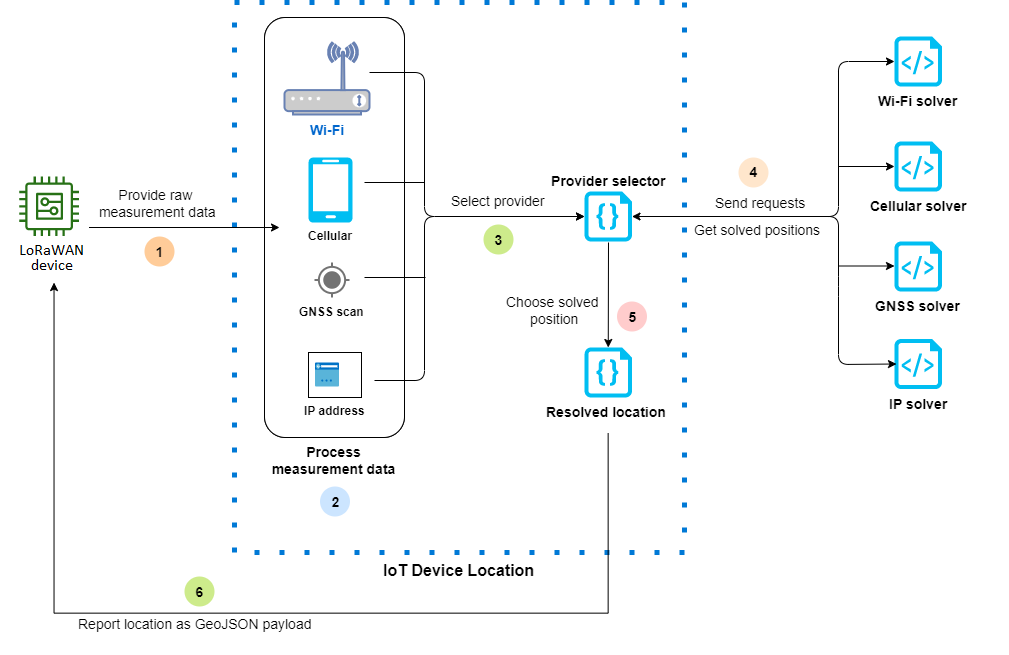AWS IoT Core Device Location
| Before using the AWS IoT Core Device Location feature, review the Terms and Conditions for
this feature. Note that AWS may transmit your geolocation search request
parameters, such as the location data used to run searches, and other
information to your chosen third party data provider, which may be outside
of the AWS Region that you are currently using. The third party provider
and the solver to be used is chosen based on the input payload received. For
more information, see AWS
Service Terms |
Use AWS IoT Core Device Location to test the location of your IoT devices using third-party solvers. Solvers are algorithms provided by third-party vendors that resolve measurement data and estimate the location of your device. By identifying the location of your devices, you can track and debug them in the field to troubleshoot any issues.
The measurement data collected from various sources is resolved, and the geolocation
information is reported as a GeoJSON
Topics
Measurement types and solvers
AWS IoT Core Device Location partners with third-party vendors to resolve the measurement data and to provide an estimated device location. The following table shows the measurement types and the third-party location solvers, and information about supported devices. For information about LoRaWAN devices and configuring device location for them, see Configuring position of LoRaWAN resources.
Note
General IoT devices and Sidewalk devices can use the device location MQTT topics to obtain the location information. For Wi-Fi, Cellular, and IP address measurement types, if the devices publish the measurement data to the reserved topics in the defined GeoJSON format, AWS IoT Core Device Location can resolve the location of the device. For GNSS measurement type, the device must have the LR11xx chip to scan the measurement data for obtaining the resolved location information using the GNSS solver. For information about obtaining location information for LoRaWAN devices, see Configuring position for LoRaWAN resources in the AWS IoT Wireless documentation.
| Measurement type | Third-party solvers | Supported devices |
|---|---|---|
| Wi-Fi access points | Wi-Fi based solver | General IoT devices, LoRaWAN, and Sidewalk devices |
| Cellular radio towers: GSM, LTE, CDMA, SCDMA, WCMDA, and TD-SCDMA data | Cellular based solver | General IoT devices, LoRaWAN, and Sidewalk devices |
| IP address | IP reverse lookup solver | General IoT devices and Sidewalk devices |
| GNSS scan data (NAV messages) | GNSS solver | General IoT devices, LoRaWAN, and devices devices |
For more information about the location solvers and examples that show the device payload for the various measurement types, see Location solvers and device payload.
How AWS IoT Core Device Location works
The following diagram shows how AWS IoT Core Device Location collects measurement data and resolves the location information of your devices.

The following steps show how AWS IoT Core Device Location works.
-
Receive measurement data
The raw measurement data related to your device location is first sent from the device. The measurement data is specified as a JSON payload.
-
Process measurement data
The measurement data is processed, and AWS IoT Core Device Location chooses the measurement data to be used, which can be Wi-Fi, cellular, GNSS scan, or IP address information.
-
Choose solver
The third-party solver is chosen based on the measurement data. For example, if the measurement data contains Wi-Fi and IP address information, it chooses the Wi-Fi solver and the IP reverse lookup solver.
-
Obtain resolved location
An API request is sent to the solver providers requesting to resolve the location. AWS IoT Core Device Location then gets the estimated geolocation information from the solvers.
-
Choose resolved location
The resolved location information and its accuracy is compared, and AWS IoT Core Device Location chooses the geolocation results with the highest accuracy.
-
Output location information
The geolocation information is sent to you as a GeoJSON payload. The payload contains the WGS84 geo coordinates, the accuracy information, confidence levels, and the timestamp at which the resolved location was obtained.
How to use AWS IoT Core Device Location
The following steps show how to use AWS IoT Core Device Location.
-
Provide measurement data
Specify the raw measurement data related to the location of your device as a JSON payload. To retrieve the payload measurement data, go to your device logs, or use CloudWatch Logs, and copy the payload data information. The JSON payload must contain one or more types of data measurement. For examples that show the payload format for various solvers, see Location solvers and device payload.
-
Resolve location information
Using the Device Location
page in the AWS IoT console or the GetPositionEstimate API operation, pass the payload measurement data and resolve the device location. AWS IoT Core Device Location then chooses the solver with the highest accuracy and reports the device location. For more information, see Resolving location of IoT devices. -
Copy location information
Verify the geolocation information that was resolved by AWS IoT Core Device Location and reported as a GeoJSON payload. You can copy the payload for use with your applications and other AWS services. For example, you can send your geographical location data to Amazon Location Service using the Location AWS IoT rule action.
The following topics show how to use AWS IoT Core Device Location and examples of device location payload.